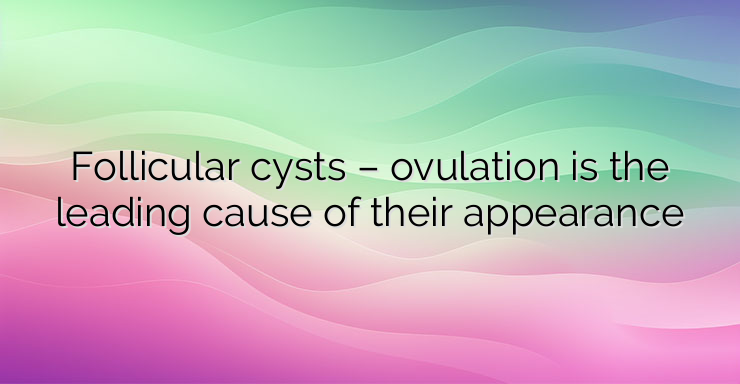Ovarian cysts are common growths that develop on or inside them. There are several types of cysts. The most common types are not life-threatening, cause no symptoms, and eventually go away without treatment. Rarely, cysts can cause complications. An ovarian cyst is a sac filled with fluid or semi-solid material that forms on or within one or both ovaries. There are different types of ovarian cysts, most of which are painless and benign. Ovarian cysts usually do not cause symptoms. In most cases, the diagnosis is made during a routine pelvic exam or imaging procedure. Rarely, ovarian cysts can cause complications. Scheduling regular gynecological exams can help prevent any problems with follicular cysts. A large percentage of ovarian cysts are functional. They are formed in response to changes in the body during the menstrual cycle. Less commonly, ovarian cysts form for reasons unrelated to menstruation. Functional cysts are the most common type of ovarian cyst and are not associated with pathological changes. They occur as a result of ovulation. These cysts may be a sign that the ovaries are functioning properly. Functional cysts usually shrink over time, usually within 60 days, without specific treatment. A small sac in the ovary called a follicle releases an egg each month as part of the menstrual cycle. A follicular cyst forms when the follicle does not release an egg. Instead, the follicle fills with fluid and grows. After the follicle releases an egg, it forms a group of hormone-producing cells called the corpus luteum. The cyst forms when fluid builds up in the corpus luteum, causing it to grow. Functional cysts are sometimes called simple cysts. Not all ovarian cysts form in response to the menstrual cycle. They are not always a sign of disease. They include: Cystadenomas These cysts form on the surface of the ovary. They can be filled with fluid that is thin and watery or thicker and mucus-like. Dermoid cysts (teratomas) Dermoid cysts consist of cells that make up all types of tissue in the human body, ranging from skin, hair, teeth, and even brain tissue. Endometriomas These cysts are filled with endometrial tissue, the same tissue that is shed each month during the cycle. Ovarian Cancer Unlike the above types of cysts, ovarian cancerous cysts (tumors) are solid masses of malignant cells. Ovarian cysts are extremely common, especially before menopause. Functional cysts are the most common type of ovarian cyst. Ovulation is the leading cause of ovarian cysts. Other causes include: Abnormal cell reproduction. Atypical cell reproduction can cause cysts such as dermoids and cystadenomas to form.Endometriosis. These cysts often form on the ovary in the advanced stages of endometriosis. Pelvic inflammatory disease. Severe pelvic infections can spread to the ovaries, causing cysts. Some smaller cysts cause no symptoms. In these cases, patients may not even realize they have a cyst. Larger cysts can cause: Pelvic pain or a dull ache in the back; A feeling of fullness (bloating) located in the lower abdomen, which may feel more pronounced on one side of the body; Pain during intercourse (dyspareunia); Painful menstrual cycle. Symptoms that persist for a long time may indicate a condition called polycystic ovary syndrome. Polycystic ovary syndrome is a condition that causes irregular periods and other hormone-related problems, including obesity and infertility. Other symptoms of PCOS include hirsutism (increased body hair growth) and difficulty losing weight. References: 1. American College of Obstetricians and Gynecologists’ Committee on Practice Bulletins—Gynecology. Practice bulletin no. 174: evaluation and management of adnexal masses. (https://pubmed.ncbi.nlm.nih.gov/27776072/) Obstet Gynecol. 2016;128(5):e210-e226. 2. Farghaly SA. Current diagnosis and management of ovarian cysts. (https://pubmed.ncbi.nlm.nih.gov/25551948/) Clin Exp Obstet Gynecol. 2014;41(6):609-612. 3. Smith-Bindman R, Poder L, Johnson E, et al. Risk of malignant ovarian cancer based on ultrasonography findings in a large unselected population. (https://pubmed.ncbi.nlm.nih.gov/30419104/) JAMA Intern Med. 2019;179(1):71-77. 4. Terzic M, Aimagambetova G, Norton M, et al. Scoring systems for the evaluation of adnexal masses naturenih.gov/27776072/) Obstet Gynecol. 2016;128(5):e210-e226. 2. Farghaly SA. Current diagnosis and management of ovarian cysts. (https://pubmed.ncbi.nlm.nih.gov/25551948/) Clin Exp Obstet Gynecol. 2014;41(6):609-612. 3. Smith-Bindman R, Poder L, Johnson E, et al. Risk of malignant ovarian cancer based on ultrasonography findings in a large unselected population. (https://pubmed.ncbi.nlm.nih.gov/30419104/) JAMA Intern Med. 2019;179(1):71-77. 4. Terzic M, Aimagambetova G, Norton M, et al. Scoring systems for the evaluation of adnexal masses naturenih.gov/27776072/) Obstet Gynecol. 2016;128(5):e210-e226. 2. Farghaly SA. Current diagnosis and management of ovarian cysts. (https://pubmed.ncbi.nlm.nih.gov/25551948/) Clin Exp Obstet Gynecol. 2014;41(6):609-612. 3. Smith-Bindman R, Poder L, Johnson E, et al. Risk of malignant ovarian cancer based on ultrasonography findings in a large unselected population. (https://pubmed.ncbi.nlm.nih.gov/30419104/) JAMA Intern Med. 2019;179(1):71-77. 4. Terzic M, Aimagambetova G, Norton M, et al. Scoring systems for the evaluation of adnexal masses nature


Leave a Reply